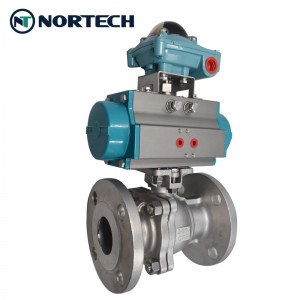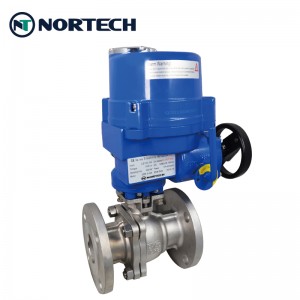Electric valve
Electric valve actuators are mainly used in power plants or nuclear power plants, because the high-pressure water system requires a smooth, stable and slow process. The main advantages of electric actuators are high stability and constant thrust that users can apply. The maximum thrust produced by the actuator can be as high as 225000kgf. Only hydraulic actuators can achieve such a large thrust, but the cost of hydraulic actuators is higher than that of electric Much higher. The anti-deviation ability of the electric actuator is very good, the output thrust or torque is basically constant, which can well overcome the unbalanced force of the medium and achieve accurate control of the process parameters, so the control accuracy is more than that of the pneumatic actuator high. If equipped with a servo amplifier, the positive and negative effects can be exchanged easily, and the signal-off valve position state (hold/full open/full close) can be easily set, and when a fault occurs, it must stay in the original position. This is Pneumatic actuators can’t do it. Pneumatic actuators must rely on a set of combined protection system to achieve position retention. The main disadvantages of electric actuators are:
The structure is more complex, and it is more prone to failure. Because of its complexity, the technical requirements for on-site maintenance personnel are relatively higher; the motor runs to generate heat. If the adjustment is too frequent, it is easy to cause the motor to overheat and generate thermal protection. At the same time, it will increase the wear of the reduction gear; in addition, it runs slower. It takes a long time from the output of a signal from the regulator to the movement of the regulating valve to the corresponding position in response. This is because it is not as good as pneumatic and hydraulic. The place of the actuator.
Pneumatic valves
The actuator and adjustment mechanism of the valve pneumatic actuator are a unified whole, and the actuator has two types: membrane type and piston type. The piston type has a long stroke and is suitable for occasions that require greater thrust; while the membrane type has a small stroke and can only directly drive the valve stem. Because the pneumatic actuator has the advantages of simple structure, large output thrust, stable and reliable action, and safety and explosion protection, it has a wide range of applications in power plants, chemical industries, oil refining and other production processes with high safety requirements.
The main advantages of pneumatic actuators:
Receive continuous air signal and output linear displacement (after power-on/air conversion device, continuous electrical signal can also be received), and some can output angular displacement when equipped with a rocker arm.
There are positive and negative functions.
The movement speed is high, but the speed will slow down when the negative wear increases.
The output force is related to the operating pressure.
The reliability is high, but the valve cannot be maintained after the air supply is interrupted (it can be maintained after adding the retaining valve).
It is inconvenient to realize segment control and program control.
The maintenance is simple, and the adaptability to the environment is good.
The output power is large. With explosion-proof function.
Electric valve actuators are mainly used in power plants or nuclear power plants, because the high-pressure water system requires a smooth, stable and slow process. The main advantages of electric actuators are high stability and constant thrust that users can apply. The maximum thrust produced by the actuator can be as high as 225000kgf. Only hydraulic actuators can achieve such a large thrust, but the cost of hydraulic actuators is higher than that of electric Much higher. The anti-deviation ability of the electric actuator is very good, the output thrust or torque is basically constant, which can well overcome the unbalanced force of the medium and achieve accurate control of the process parameters, so the control accuracy is more than that of the pneumatic actuator high. If equipped with a servo amplifier, the positive and negative effects can be exchanged easily, and the signal-off valve position state (hold/full open/full close) can be easily set, and when a fault occurs, it must stay in the original position. This is Pneumatic actuators can’t do it. Pneumatic actuators must rely on a set of combined protection system to achieve position retention. The main disadvantages of electric actuators are:
The structure is more complex, and it is more prone to failure. Because of its complexity, the technical requirements for on-site maintenance personnel are relatively higher; the motor runs to generate heat. If the adjustment is too frequent, it is easy to cause the motor to overheat and generate thermal protection. At the same time, it will increase the wear of the reduction gear; in addition, it runs slower. It takes a long time from the output of a signal from the regulator to the movement of the regulating valve to the corresponding position in response. This is because it is not as good as pneumatic and hydraulic. The place of the actuator.
Pneumatic valves
The actuator and adjustment mechanism of the valve pneumatic actuator are a unified whole, and the actuator has two types: membrane type and piston type. The piston type has a long stroke and is suitable for occasions that require greater thrust; while the membrane type has a small stroke and can only directly drive the valve stem. Because the pneumatic actuator has the advantages of simple structure, large output thrust, stable and reliable action, and safety and explosion protection, it has a wide range of applications in power plants, chemical industries, oil refining and other production processes with high safety requirements.
The main advantages of pneumatic actuators:
Receive continuous air signal and output linear displacement (after power-on/air conversion device, continuous electrical signal can also be received), and some can output angular displacement when equipped with a rocker arm.
There are positive and negative functions.
The movement speed is high, but the speed will slow down when the negative wear increases.
The output force is related to the operating pressure.
The reliability is high, but the valve cannot be maintained after the air supply is interrupted (it can be maintained after adding the retaining valve).
It is inconvenient to realize segment control and program control.
The maintenance is simple, and the adaptability to the environment is good.
The output power is large. With explosion-proof function.
Nortech is one of the leading industrial valve manufacturers in China with quality certification ISO9001.
Major products: Butterfly Valve, Ball Valve,Gate Valve, Check Valve, Globe Vavlve,Y-Strainers, Electric Acurator , Pneumatic Acurators .
Post time: Jul-19-2021


